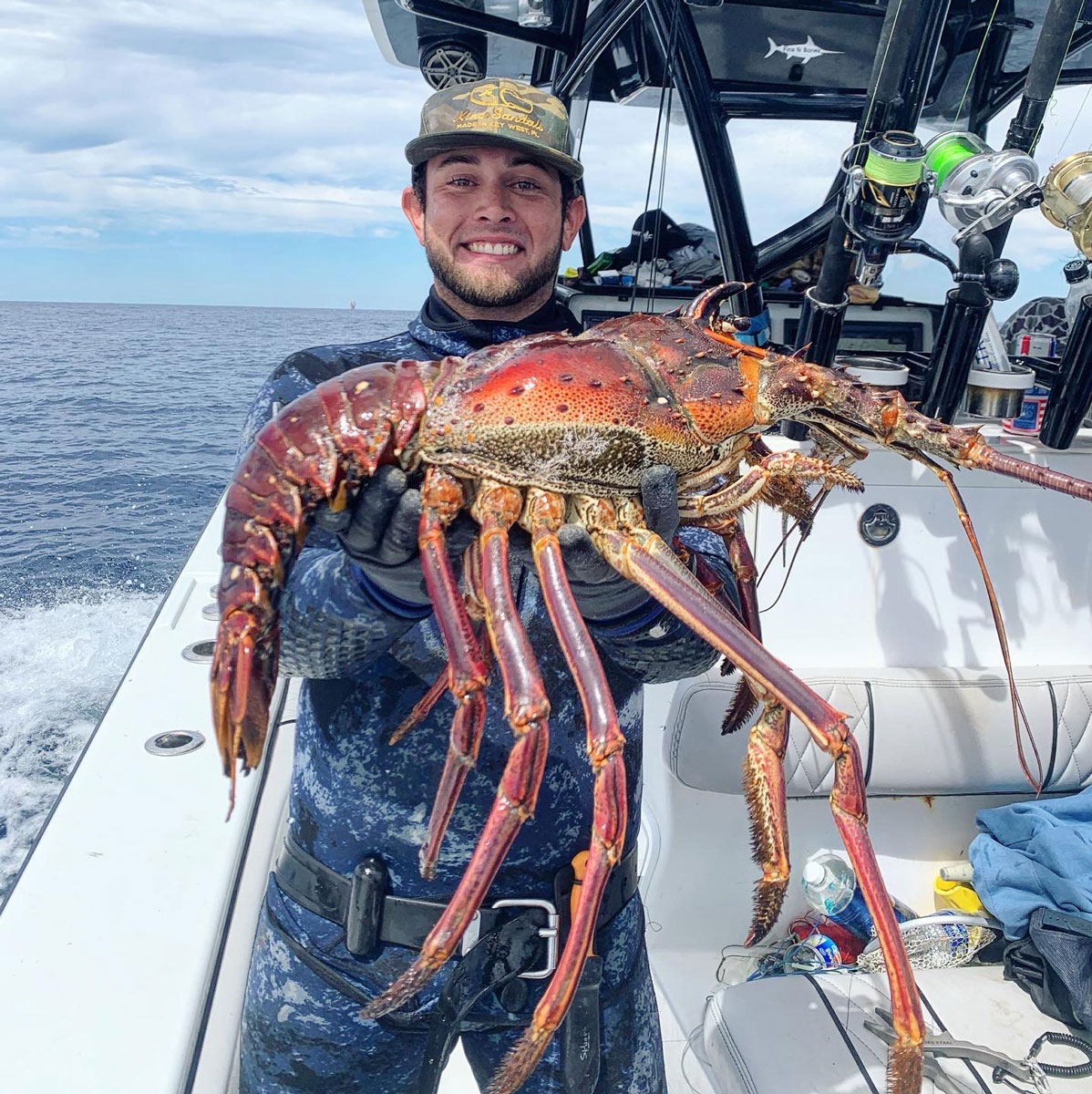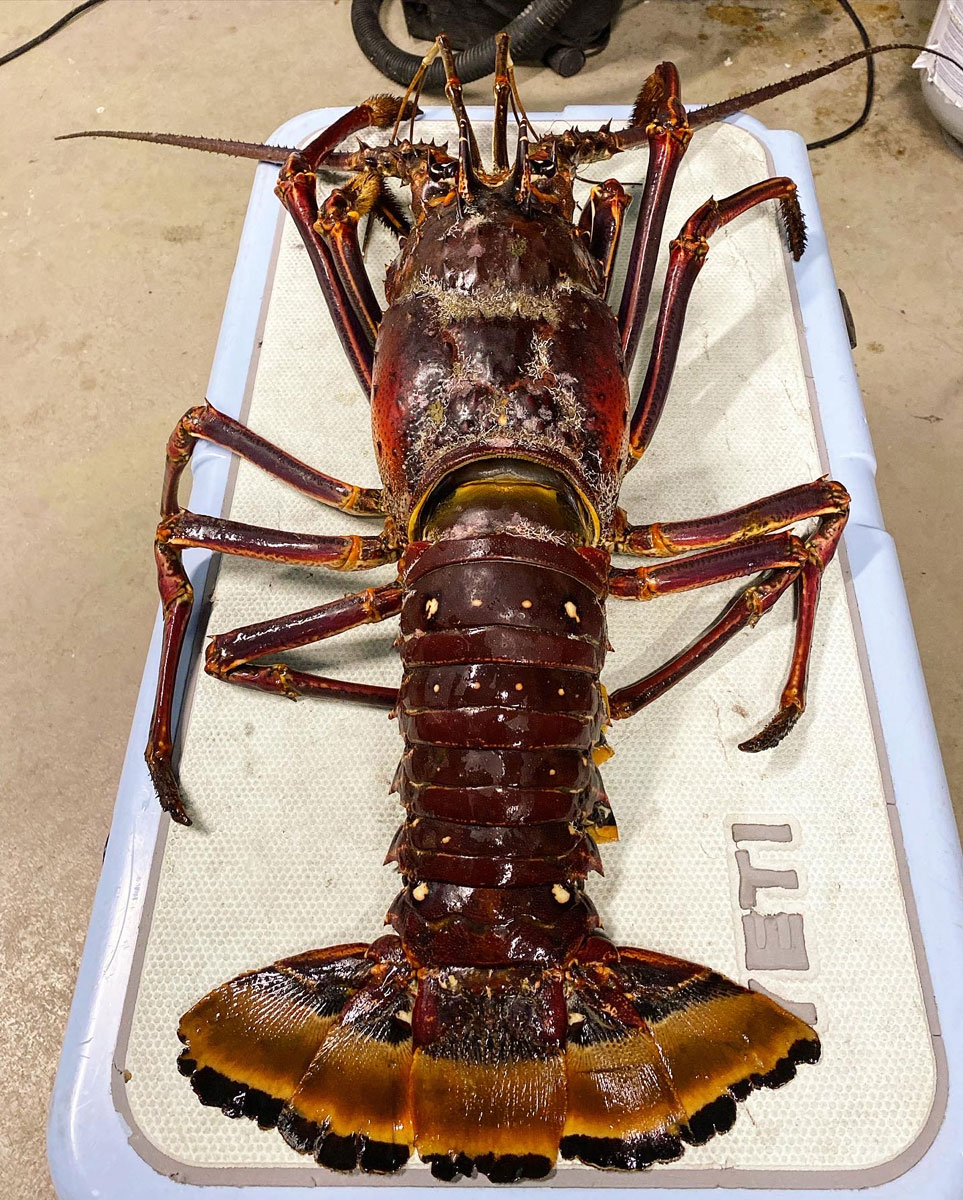
When people think of Louisiana crustaceans, they naturally envision a table heaped with boiled crawfish, shrimp and crabs, but lobster?
While free-diving in the Gulf of Mexico about 65 miles south of Grand Isle, Elliott Boudreaux, a 23-year-old student from Thibodaux, found a whopper crustacean that most people probably cannot believe live off the Louisiana coast.
“We launched out of Grand Isle and wanted to shoot some yellowfin tuna for my friend’s birthday,” Boudreaux said. “We originally went almost to the Venice area to look for yellowfins by some shrimp boats. At about midday, we figured out that the original plan wasn’t working so we called an audible and went to some rigs south of Grand Isle.”
Cameron Stone owns the boat. Besides Boudreaux, Ronnie Joe Collins and Tyler Stone comprised the crew that day. On land, Boudreaux can hold his breath for about three minutes and over two minutes in the water.
“We try to go offshore whenever the weather allows,” Boudreaux said. “I’ve been diving for about three years and have been down to as much as 71 feet on one breath. During my first year of diving, one of my mentors caught a lobster. I thought that was so cool that he caught a lobster in Louisiana waters. From that day on, I’ve been looking for them.”
Caribbean spiny lobster
Not the kind of oversized crawfish with big claws one would expect to find in Maine or order in finer seafood restaurants, clawless Caribbean spiny lobsters live in the Gulf and Atlantic Ocean from Texas to North Carolina. They like to hang around reefs, platforms, mangrove trees and other places with good structure. Although clawless, their shelled bodies covered with spines make them a formidable adversary. They normally stay at depths of 100 to 350 feet deep.
“Caribbean spiny lobsters inhabit bays, estuarine areas, coral reefs and other offshore habitats, but are found on soft bottoms and seagrass during migratory periods,” said Peyton Cagle, the Louisiana Department of Wildlife and Fisheries crustacean program manager in Lake Charles. “Louisiana has plenty of soft-bottom habitat and offshore structures that provide habitat. It is likely that higher salinities in state estuarine and nearshore waters due to the drought and low Mississippi River water levels, have allowed spiny lobster to become more present in the area where the fisher reported landing the catch.”
The species can reach about three feet long and weigh up to 18 pounds. Two very long antennas can measure more than their body length. These lobsters typically eat mollusks and any dead animal or vegetable matter they find on the bottom. In turn, they provide prey for passing octopus, nurse sharks or game fish like snapper and grouper.
Florida holds a lobster season on this species. People can order them in seafood restaurants. According to the National Oceanic and Atmospheric Administration, commercial fishermen landed about 5.5 million pounds of spiny lobsters in the Gulf of Mexico and Atlantic Ocean in 2022.
“This species is managed under federal regulations, meaning there are no Louisiana state regulations for it,” Cagle said. “That means they can be harvested as long as there is no federal closure on them in the Gulf of Mexico.”
An eventful dive
Now attending Fletcher Technical Community College in Houma to study business, Boudreaux wants to become a commercial diver and one day open his own diving business. For now, the young entrepreneur runs a lawn care service. On this day, he served as the safety diver watching out for the others.
“We were free-diving with no scuba tanks in water about 450 to 500 feet deep,” Boudreaux said. “I thought a lot about doing scuba, but for me, it takes a lot of the athleticism out of it. Also, it becomes more dangerous breathing at depth versus listening to my body and staying within my limits.”
 After a few warm-up dives, Boudreaux spotted a big lobster about 50 feet down on one of the rig legs. He could see the crustacean’s long antennas sticking out of a pipe.
After a few warm-up dives, Boudreaux spotted a big lobster about 50 feet down on one of the rig legs. He could see the crustacean’s long antennas sticking out of a pipe.
“Because it had been so hot lately, the fish were really deep,” Boudreaux said. “When we got into the water that day, it was cooler, crystal clear and blue. As soon as we got into the water, we saw life everywhere. This was only the second lobster I’ve ever seen diving and I went straight for him. I didn’t realize how big he was until I got my hands on him. I couldn’t reach around his shell with one hand.”
Boudreaux finally managed to wrestle control of the armored beast from the deep and pull it out of its lair. The crustacean weighed more than 11 pounds. From the tip of its nose to the tip of its tail measured about two feet, not counting the extra-long antennas.
“I put him on the tailgate of a truck,” Boudreaux said. “His tail went over one end of the tailgate and his antennas touched the other side. I didn’t think they even got close to that big. We cleaned his tail out, making sure we were careful not to break the shell. With the tail meat, I made a huge batch of lobster mac and cheese. It came out awesome.”
Boudreaux kept the empty shell and plans to get it mounted as a reminder of that memorable day south of Grand Isle.